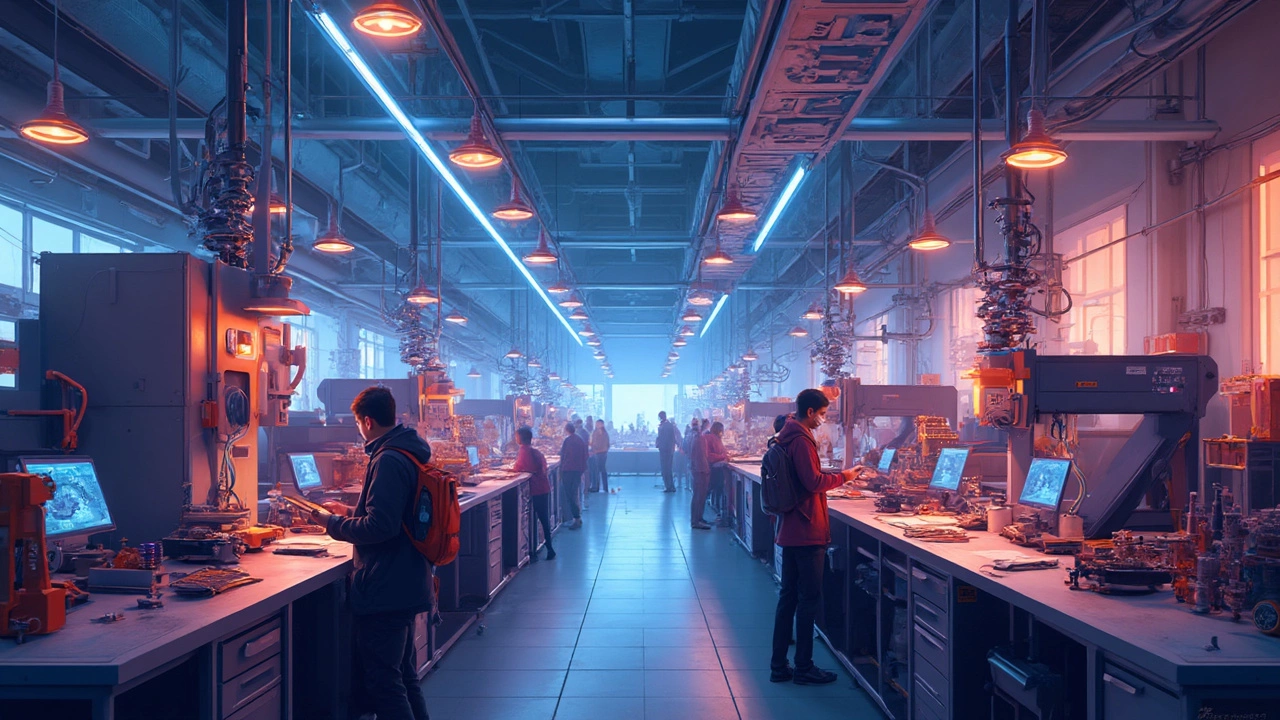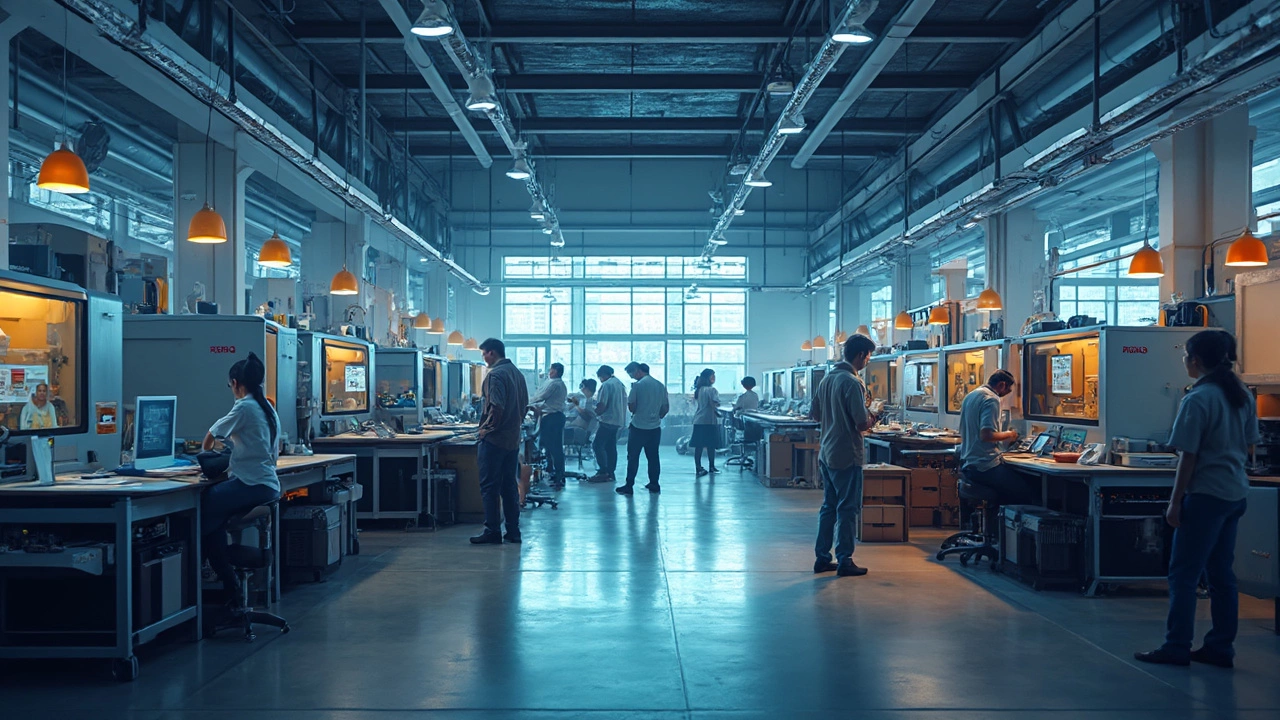Ever thought of diving into the world of small-scale manufacturing? It's a nifty idea, especially if you're looking to make some serious cash with the right machines. But let's be honest, not all machines are created equal when it comes to making money. So which ones really stand out in the profit game?
Think about CNC machines. These bad boys are a favorite in the manufacturing world, thanks to their precision and versatility. You can use them to create everything from intricate metal parts to wooden designs, and they do it efficiently. This not only gets your products out the door faster but also keeps your customers coming back for more.
- Introduction to Profitable Machinery
- CNC Machines: Precision and Profit
- 3D Printing: The Future of Manufacturing
- Packaging Equipment: Efficiency Gains
- Considerations for Choosing Machinery
- Tips for Maximizing Profitability
Introduction to Profitable Machinery
So, you're interested in small-scale manufacturing and want to know which machines rake in the most cash? You're in the right place. The world of manufacturing has evolved big time, thanks to technology. Machines that were once only accessible to big corporations are now affordable and efficient enough for smaller setups. But to make the most out of this, you’ve got to know which machines to choose.
Starting with the CNC machines, these are heavy hitters in terms of profitability. Known for their precision, they save you time and reduce wastage—two big pluses when you're thinking about the bottom line. CNC machines can handle a range of materials, from metals to plastics, making them super versatile.
Next up is 3D printing. This might seem like tech from the future, but it’s very much of the now! Small businesses use 3D printers to quickly prototype and produce customized products without the cost of traditional manufacturing methods. It breaks down the barrier to entry for making specialty items and helps businesses test the market without huge investments.
Packaging equipment is another area where you can significantly boost efficiency—automating this part of your process means faster turnarounds and lower labor costs. It's all about giving your business that competitive edge in terms of production efficiency.
To make well-informed decisions, it's crucial to not just consider the purchase cost of a machine but also its operational expense, maintenance needs, and how it will fit into your existing workflow. Think about the long-term benefits these machines can bring, like agility and scalability.
CNC Machines: Precision and Profit
When it comes to small-scale manufacturing, CNC machines are like the rockstars of the industry. Why? Because they bring precision to a whole new level. With computer-controlled systems, these machines can carve, cut, and shape materials like metal, wood, and plastic with incredible accuracy. It's like having an artist with a laser-focused eye working on your projects every time.
Now, let's talk numbers. On average, a CNC machine can boost production efficiency by around 40-50%. That means fewer mistakes, less waste, and more of what you make reaching market-ready status. Not to mention, these machines run with minimal input once set up, so you and your team can focus on other tasks, like expanding your customer base or dreaming up your next big product line.
But why stop there? Let's look at a few reasons why CNC machines can seriously impact your bottom line:
- Versatility: Whether you're crafting custom furniture or intricate mechanical parts, CNC machinery handles it all. This multifunctionality can open doors to different markets without the need for additional investment in different equipment.
- Repeatability: Delivering consistent quality is crucial for retaining clients and building your reputation. CNC machines ensure each piece matches precise specifications time and time again.
- Time Efficiency: With automated operations, CNC machines cut down on manual labor time drastically, allowing you to churn out products faster, keeping up with demand.
Worried about the initial costs? While CNC machines require a hefty upfront investment, the potential return is significant. Most businesses see payback within a couple of years, and the long-term savings and profits outweigh the initial expense. Investing smartly in one of these machines can position your small-scale manufacturing business on the fast track to success.
3D Printing: The Future of Manufacturing
3D printing has been a game changer in the world of small-scale manufacturing. It's like having a magic wand that creates objects layer by layer, turning digital designs into solid reality. What's really cool is how this tech makes prototyping cheap and fast. Need to tweak a design? No problem. You can make adjustments in the software and print a new version without breaking the bank.
From jewelry to car parts, 3D printers handle it all, thanks to a variety of materials like plastics, resins, and even metals. They offer flexibility that traditional methods just can't match. Plus, the cost is dropping, making these machines more accessible to hobbyists and businesses alike. Imagine running a business from your garage, crafting custom phone cases or unique home decor items with ease. The possibilities seem endless!
Let’s look at some interesting stats:
| Year | Market Growth (%) | Global Revenue (Billion USD) |
|---|---|---|
| 2023 | 20 | 16.5 |
| 2024 | 22 | 20.1 |
| 2025 | 25 | 25.4 |
That’s some serious growth, right? No wonder more folks are jumping into 3D printing. But before you start shopping for a printer, there are tips to keep in mind. Consider the type of materials you’ll work with, the volume you need, and your budget. Research and compare models; some are better for precise small items, while others handle larger objects with ease.
Whether you’re creating prototypes or final products, 3D printing is unlocking opportunities that were pure sci-fi just a decade ago. It's a blend of creativity and technology that opens new doors in the manufacturing industry. With the right machine, you can definitely ride this wave to business success and creative satisfaction.

Packaging Equipment: Efficiency Gains
When it comes to small-scale manufacturing, packaging equipment can be a game changer. Why does it matter so much? Well, efficient packaging not only improves the look of your products but also protects them during transit, ensuring they reach your customers in tip-top shape. Nobody likes damaged goods, right?
Nowadays, you can find a range of packaging machines that cater to different needs and budgets. For example, let's talk about automated sealing machines. These are fantastic for speeding up the packaging process. Instead of manually sealing every package, you can process dozens in the same amount of time. More output, more profits—simple math!
Another useful piece of equipment is labeling machines. They're perfect for giving your products that professional touch. A good label can make a product stand out on a shelf, and if you're scaling up, automatic labeling saves a ton of time compared to doing it by hand. Plus, consistent labeling minimizes errors, keeping your brand image consistent and reliable.
- Automatic Sealing Machines: Great for increasing speed and efficiency in packaging.
- Labeling Machines: Essential for brand consistency and reducing manual labor.
- Filling Machines: Ideal for liquid or powder products, ensuring precise measurements and reducing waste.
Choosing the right packaging equipment can enhance your production line significantly. With a bit of research and investment, these machines can offer impressive efficiency gains, allowing you to focus on other aspects of your business. Remember, a streamlined packaging process not only benefits the bottom line but also keeps customers happy with reliable and well-presented products.
Considerations for Choosing Machinery
Picking the right machinery for your small-scale manufacturing venture isn't just about grabbing what's trendy. It's about finding what fits your business needs and budget perfectly. So, what should you actually keep an eye on when making this decision?
First off, think about your product line. Different products require different manufacturing equipment. For instance, if you're into intricate designs, a CNC machine might be just what you need for precision cutting. On the other hand, for more innovative or customized products, 3D printing could be your best bet.
Next, let’s talk about budget. Fancy machines with all the bells and whistles can be tempting, but you need to balance cost with functionality. Sometimes the mid-range options offer the best value. Just ensure it meets your production needs without blowing a hole in your wallet.
Space is another biggie. Some machines are pretty massive, so make sure you’ve got enough room in your workshop. No point buying a giant piece of kit if it won’t even fit through the door!
- Product fit: Match the machine with your product needs.
- Budget: Weigh cost against functionality.
- Space requirements: Ensure you’ve got the room.
- Maintenance: Consider ongoing costs and support.
Lastly, don't forget about maintenance and support. Machines are like cars—they need regular maintenance to run smoothly. Check if parts and service are easy to get. Sometimes it's worth spending a bit more upfront on a machine that's cheaper to maintain in the long run.
Here's a quick breakdown of average maintenance costs for common equipment:
| Machine Type | Annual Maintenance Cost (£) |
|---|---|
| CNC Machines | 1,500 |
| 3D Printers | 1,000 |
| Packaging Equipment | 800 |
Happy machine hunting! With these tips, you're setup to make a smart, informed choice that’ll pay off in the long run.
Tips for Maximizing Profitability
So, you’ve got your small-scale manufacturing setup ready. But how do you squeeze the most profit out of it? It’s not just about turning machines on and letting them do their thing. You’ve got to be strategic about it.
First off, know your costs inside out. This might sound obvious, but it’s easy to overlook things like maintenance and energy costs when you're knee-deep in production. Regular maintenance on machines can prevent unexpected breakdowns that could stop your operations and cost you big time.
You’ll want to make sure you're making the most out of your machinery. Optimizing production schedules can keep the machines running smoothly and efficiently. Consider implementing a lean manufacturing approach to cut down on waste and improve efficiency. This method is all about maximizing value by minimizing wasted resources and time.
Invest in staff training, too. Skilled workers who know how to handle your equipment not only reduce errors but also help in maximizing productivity. Remember, machines need smart minds to operate at their best!
Also, keep an eye on market demand. The products you’re manufacturing should align with current trends and consumer interests. Check in with retailers or tap into online market data to ensure you're on top of what’s selling hot.
Sometimes, it's not just the product but how it's packaged. Investing in quality packaging equipment can enhance the perceived value of your products, making them more attractive and potentially allowing for higher pricing.
Consider diversifying your product range. If you're only making one type of product, a shift in market demand can hit your profits hard. By producing a variety of products, you can spread your risk.
Finally, don’t shy away from leveraging technology. Tools like AI for monitoring production processes can give you insights to further optimize operations and improve your bottom line. In case you're curious about popular equipment in the space, some shared resources might break it down as below:
| Equipment | Potential Profit Increase (%) |
|---|---|
| CNC Machines | 30% |
| 3D Printers | 25% |
| High-Efficiency Packaging | 20% |
So, stay informed, keep innovating, and watch your profits grow!
